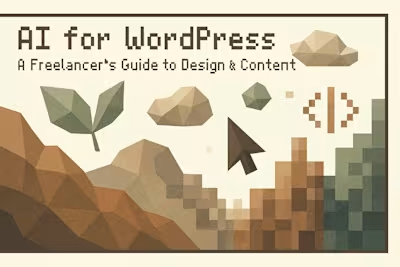Freelance WordPress Pricing: Hourly, Fixed, or Value-Based? A Comprehensive Guide

Freelance WordPress Pricing: Hourly, Fixed, or Value-Based? A Comprehensive Guide
The Classic Approach: Hourly Rates
Pros of Hourly Pricing
Cons of Hourly Pricing
Project Certainty: Fixed-Price Projects
When to Use Fixed-Price
The Dangers of Scope Creep and How to Manage It
The Expert's Choice: Value-Based Pricing
How to Determine a Project's Value to the Client
Why Value-Based Pricing Leads to Higher Earnings
Which Model is Right for You?
A Hybrid Approach: Combining Models for Maximum Effect
Making Your Pricing Decision
References
Freelance WordPress Pricing: Hourly, Fixed, or Value-Based? A Comprehensive Guide
Pricing your services is one of the most critical and challenging tasks for any WordPress freelancer. The right model can lead to profitability and client satisfaction, while the wrong one can cause stress and financial strain. This guide breaks down the three core pricing models—hourly, fixed-price, and value-based—to help you decide which is best for your business.
Understanding these structures is the first step toward building a sustainable and successful freelance career. As you grow, you may even want to productize your services, which can simplify sales and create predictable income. A key part of this journey is finding clients who appreciate the value you bring, and platforms make it easier than ever to hire top WordPress freelancers who understand market rates.
The Classic Approach: Hourly Rates
Charging by the hour is often the starting point for new freelancers because it's simple to understand and implement. You track your time, send an invoice, and get paid. It's straightforward and feels fair to both parties at first glance.
This model involves tracking the time spent on a project and billing the client for those hours. It's best used for projects with an undefined scope or for ongoing maintenance tasks where the workload can fluctuate. Think of it like a taxi meter—the longer the ride, the more you pay.
Many WordPress developers start here because it requires minimal business experience. You don't need to estimate project complexity or negotiate complex contracts. Just work and bill. But as you'll see, this simplicity comes with hidden costs.
Pros of Hourly Pricing
The primary benefit of hourly rates is flexibility. You are compensated for all the time you work, including unexpected revisions or additions. This model protects you from under-quoting on projects with many unknowns.
Let's say a client asks for "just a quick change" to their navigation menu. What starts as a 30-minute task turns into three hours of debugging a theme conflict. With hourly billing, you're covered. Every minute counts toward your paycheck.
Hourly rates also work well for maintenance contracts. When a client needs ongoing support but can't predict exactly how much, hourly billing provides a fair solution. They pay for what they use, and you get compensated for every support ticket.
For new freelancers, hourly pricing reduces risk. You don't need years of experience to estimate project timelines accurately. As long as you track your time honestly, you'll get paid fairly. This makes it an excellent starting point while you build your skills and client base.
Cons of Hourly Pricing
Here's the uncomfortable truth: hourly billing can punish efficiency. The faster you work, the less you earn for the same task. Master a technique that cuts development time in half? Congratulations, you just gave yourself a 50% pay cut.
This model also creates an income ceiling tied directly to the number of hours you can work. Even if you bill $150 per hour and work 50 hours a week, your income hits a hard limit. There's no scaling beyond trading more time for more money.
Clients often struggle with hourly pricing too. They can't budget accurately when they don't know the final cost upfront. This uncertainty makes them nervous, leading to constant check-ins about hours spent and work remaining. Nobody enjoys those conversations.
The psychological impact matters too. When clients see hourly invoices, they focus on time rather than value. They might question why a simple form took three hours or compare your rates to offshore developers. You're selling time, not expertise or results.
Project Certainty: Fixed-Price Projects
A fixed-price model involves setting a single, upfront price for an entire project based on a clearly defined scope. This approach is favored by clients who need budget certainty and is ideal for projects with well-understood deliverables, like a standard five-page brochure website.
Fixed pricing shifts the conversation from "how long will this take?" to "what will this cost?" Clients love knowing their exact investment upfront. They can budget confidently and get approval from stakeholders without worrying about runaway costs.
For freelancers, fixed pricing rewards efficiency. Finish a $5,000 project in 20 hours instead of 40? You just doubled your effective hourly rate. This incentive drives you to improve processes, reuse code, and work smarter rather than longer.
When to Use Fixed-Price
Use this model when the project requirements are crystal clear and you can accurately estimate the time and effort involved. It requires a detailed scope of work (SOW) to be agreed upon before starting.
Fixed pricing works best for:
Standard WordPress installations with defined features
Theme customizations with specific requirements
Migration projects with known content volumes
Landing pages with approved designs
Small business websites with standard functionality
The key is predictability. If you've built similar sites before, you can estimate accurately. A five-page site for a local restaurant? You know that drill. A custom membership portal with complex user roles? Maybe stick to hourly until you understand the full scope.
Experience matters here. After completing dozens of projects, you develop an intuition for hidden complexity. That "simple" contact form might need custom validation. The "basic" gallery could require specific mobile behaviors. Your estimates improve with every project.
The Dangers of Scope Creep and How to Manage It
The biggest risk with fixed-price projects is scope creep, where the client's requests expand beyond the original agreement. What starts as a simple blog becomes an e-commerce platform. The contact form grows into a full CRM integration.
Scope creep kills profitability faster than any other factor. Those "small" additions eat into your margin until you're working for minimum wage. Worse, saying no after saying yes to previous requests damages client relationships.
Preventing scope creep requires discipline:
First, write detailed project scopes. List every feature, page, and function explicitly. Include what's NOT included too. Specify the number of design revisions, content rounds, and testing cycles. Leave nothing to interpretation.
Second, implement a strict change control process. When clients request additions, pause and document. Explain how the new feature affects timeline and budget. Provide a written change order with additional costs. Get approval before proceeding.
Your contract must support this process. Include clear language about additional work requiring separate agreements. Define what constitutes a change versus a clarification. Protect yourself legally while maintaining positive client relationships.
Communication prevents most scope creep. Regular check-ins keep everyone aligned. Share progress early and often. When clients see work materializing, they're less likely to pivot dramatically. Surprises breed scope creep; transparency prevents it.
The Expert's Choice: Value-Based Pricing
Value-based pricing is an advanced model where the fee is based on the perceived or actual value the service delivers to the client's business, not the time it takes to complete. The focus shifts from your inputs to the client's outcomes, such as increased revenue or reduced costs.
This model represents the pinnacle of freelance pricing strategy. Instead of selling hours or deliverables, you're selling transformation. A new website isn't just code and design—it's increased sales, improved brand perception, or streamlined operations.
Value-based pricing requires a fundamental mindset shift. Stop thinking like a technician and start thinking like a business consultant. Your WordPress expertise becomes a tool for achieving business objectives, not an end in itself.
How to Determine a Project's Value to the Client
This requires in-depth discovery calls to understand the client's business goals. Skip the technical requirements initially. Instead, dig into their business challenges, growth plans, and success metrics.
Ask questions like:
What business problem does this website solve?
How much revenue does your current site generate?
What would a 20% conversion increase mean financially?
How much are you losing to poor user experience?
What's the cost of maintaining your current system?
For example, if a new e-commerce site is projected to generate $100,000 in additional annual revenue, a project fee of $15,000 becomes a justifiable investment. The client sees ROI, not expense.
Sometimes value isn't just revenue. A nonprofit might value increased donations, volunteer signups, or community engagement. A B2B company might prioritize lead quality over quantity. Understanding these nuances lets you price accordingly.
Document everything during discovery. When you present your proposal, tie every feature to a business outcome. The shopping cart isn't just functional—it reduces abandonment by 30%. The contact form doesn't just work—it qualifies leads automatically.
Why Value-Based Pricing Leads to Higher Earnings
This model decouples your income from your time, allowing you to earn based on your expertise and the results you deliver. It positions you as a strategic partner rather than just a service provider, which clients value highly.
Think about it: solving a $100,000 problem in 10 hours provides more value than solving a $1,000 problem in 100 hours. Value-based pricing rewards you for tackling bigger challenges efficiently.
The earning potential is transformative. While hourly freelancers hit income ceilings, value-based practitioners scale exponentially. That same WordPress site might take 40 hours whether you charge hourly or value-based. But at $100/hour, you earn $4,000. Priced at 10% of projected value? That's $10,000 or more.
This model also attracts better clients. Business owners who understand ROI make decisions faster and respect expertise more. They're investing in outcomes, not buying time. These relationships feel more like partnerships than vendor arrangements.
Your expertise compounds with value-based pricing. Each successful project builds case studies and confidence. You learn which solutions drive specific results. This knowledge lets you price future projects more accurately and deliver value more reliably.
Which Model is Right for You?
The best pricing model depends on your experience, the project's complexity, and your client. New freelancers may start with hourly rates and move to fixed-price as they gain confidence in their estimates. Experienced freelancers often gravitate toward value-based pricing to maximize their income.
Consider your current situation honestly. If you're still learning WordPress development, hourly pricing protects you while building skills. There's no shame in starting simple. Even experienced developers use hourly rates for certain scenarios.
Your client type matters too. Small businesses with tight budgets often prefer fixed prices for predictability. Enterprises might insist on hourly rates for compliance reasons. Startups focused on growth respond well to value-based proposals.
Project complexity influences model choice. Maintenance and support work fits hourly billing naturally. Standard websites suit fixed pricing. Strategic initiatives that transform businesses deserve value-based consideration.
A Hybrid Approach: Combining Models for Maximum Effect
You don't have to stick to just one model. Consider using a fixed price for the core project and an hourly rate for ongoing support. Or, use a value-based fee for a new website build and offer a monthly retainer for maintenance and updates.
Here's a real-world example: Quote $8,000 fixed price for a WordPress e-commerce build. Include specific features, pages, and functionality. Then offer a $500/month maintenance retainer covering updates, backups, and two hours of changes. Additional work beyond the retainer bills at $125/hour.
This hybrid approach gives clients budget certainty for the main investment while providing flexibility for ongoing needs. You get a solid project fee plus recurring revenue. Everyone wins.
Some freelancers use different models for different service lines. Website builds might be value-based. Custom plugin development could be fixed-price. Troubleshooting and fixes stay hourly. This specialization lets you optimize pricing for each service type.
The key is transparency. Explain your pricing logic to clients. Show them why each model makes sense for different scenarios. When they understand the reasoning, they're more likely to accept your recommendations.
Making Your Pricing Decision
Choosing the right pricing model isn't a one-time decision. Your approach should evolve with your skills, client base, and business goals. Start where you're comfortable, experiment with different models, and adjust based on results.
Remember that pricing is as much about psychology as mathematics. Clients buy confidence as much as competence. Whatever model you choose, own it completely. Hesitation or uncertainty during pricing discussions undermines your professionalism.
Track your results religiously. Note which models generate the most profit, attract the best clients, and create the least stress. Data beats gut feelings when optimizing your business model.
Most importantly, remember that your pricing reflects your value. As you grow more skilled and deliver better results, your pricing should grow too. Don't let imposter syndrome keep you stuck at outdated rates.
The WordPress ecosystem offers endless opportunities for skilled freelancers. Whether you choose hourly, fixed, or value-based pricing, focus on delivering exceptional results. Happy clients lead to referrals, case studies, and the confidence to charge what you're truly worth.
Your pricing journey is unique. Start with the model that feels right today. Build your skills, serve your clients well, and evolve your pricing as you grow. The perfect pricing strategy is the one that sustains your business while delivering value to clients.
References
Like this project
Posted Jul 6, 2025
Confused about how to price your WordPress services? Explore the pros and cons of hourly, fixed-price, and value-based pricing to maximize your freelance income.









